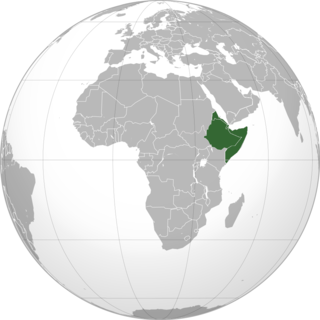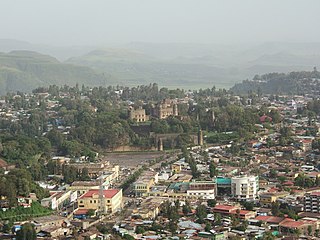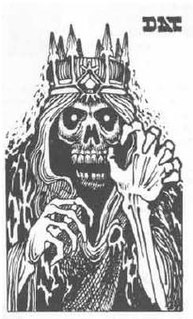
The Battle of Adwa was the climactic battle of the First Italo-Ethiopian War. Led by Emperor Menelik II, Ethiopian forces defeated an invading Italian force on March 1, 1896, near the town of Adwa in Tigray. The decisive victory thwarted the Kingdom of Italy's campaign to expand its colonial empire in the Horn of Africa and secured the Ethiopian Empire's sovereignty for another forty years. As the only African nation to successfully resist European conquest during the scramble for Africa, Ethiopia became a preeminent symbol of the pan-African movement and international opposition to colonialism.
"Eritrea" is an ancient name, associated in the past with its Greek form Erythraia, Ἐρυθραία, and its derived Latin form Erythræa. This name relates to that of the Red Sea, then called the Erythræan Sea, from the Greek for "red", ἐρυθρός, erythros. The Italians created the colony of Eritrea in the 19th century around Asmara, and named it with its current name. After World War II Eritrea was annexed to Ethiopia. In 1991 the Eritrean People's Liberation Front defeated the Ethiopian "derg" government. Tigray is a region of Ethiopia whose religions, food, language and culture are the same as that of the greater part of Eritrea. A lot of people have families on both sides of the border between Eritrea and Tigray. Eritrea officially celebrated its 1st anniversary of independence on May 24, 1991.

The Horn of Africa is a peninsula in Northeast Africa. It extends hundreds of kilometers into the Arabian Sea and lies along the southern side of the Gulf of Aden. The area is the easternmost projection of the African continent. Referred to in ancient and medieval times as the land of the Barbara and Habesha, the Horn of Africa denotes the region containing the countries of Djibouti, Eritrea, Ethiopia, and Somalia.

In fantasy fiction, a lich is a type of undead creature. Often such a creature is the result of a transformation, as a powerful magician skilled in necromancy or a king striving for eternal life using spells or rituals to bind his intellect and soul to his 'phylactery' and thereby achieving a form of immortality. Liches are depicted as being clearly cadaverous, bodies desiccated or completely skeletal. Liches are often depicted as holding power over hordes of lesser undead creatures, using them as soldiers and servants. Unlike zombies, which are often depicted as mindless, a lich is sapient, retaining independent thought and is as intelligent as it was prior to its transformation.

Menelik II GGCB, GCMG was Emperor of Ethiopia from 1889 to his death in 1913 and Negus (King) of Shewa (1866–89). At the height of his internal power and external prestige, the process of territorial expansion and creation of the modern empire-state was completed by 1898, which expanded the Ethiopian Empire to the extent of the historic Aksumite Empire. Menelik was also remembered for leading Ethiopian troops against the Kingdom of Italy in the First Italo-Ethiopian War, where Menelik scored a decisive victory at the Battle of Adwa.

Harar, and known to its inhabitants as Gēy, is a walled city in eastern Ethiopia. It was formerly the capital of Hararghe and now the capital of the modern Harari Region of Ethiopia. The city is located on a hilltop in the eastern extension of the Ethiopian Highlands, about five hundred kilometers from the national capital Addis Ababa at an elevation of 1,885 meters. Based on figures from the Central Statistical Agency in 2005, Harar had an estimated total population of 122,000, of whom 60,000 were males and 62,000 were females. According to the census of 1994, on which this estimate is based, the city had a population of 76,378.

Ogaden is the historical name of the modern Somali Region, the territory comprising the eastern portion of Ethiopia formerly part of the Hararghe province. The inhabitants are predominantly ethnic Somalis. The Ogaden (clan) of the Darod constitute the majority in the region, although this is disputed. Other Somali clans in the region are Isaaq,Gadabuursi, Issa and Hawiye clans.

Gondar or Gonder is a city and separate woreda in Ethiopia. Located in the Semien Gondar Zone of the Amhara Region, Gondar is north of Tana Lake on the Lesser Angereb River and southwest of the Simien Mountains. It has a latitude and longitude of 12°36′N37°28′E with an elevation of 2133 meters above sea level. It is surrounded by the Gondar Zuria woreda. Gondar served as a strong Christian kingdom for many years.

Arnaud-Michel d'Abbadie was an Irish-born French and Basque geographer, and along with his older brother Antoine-Thomson d'Abbadie, was notable for his travels in Ethiopia.

The Ogaden War was a Somali military offensive between July 1977 and March 1978 over the disputed Ethiopian region of Ogaden, which began with the Somali invasion of Ethiopia. The Soviet Union disapproved of the invasion and ceased its support of Somalia, instead starting to support Ethiopia; the United States, conversely, ceased its support of Ethiopia and started supporting Somalia. Ethiopia was saved from a major defeat and a permanent loss of territory through a massive airlift of military supplies, the arrival of 16,000 Cuban troops, 1,500 Soviet advisors and two brigades from South Yemen, also airlifted to reinforce Harar. The Ethiopians prevailed at Harar, Dire Dawa and Jijiga, and began to push the Somalis systematically out of the Ogaden. By March 1978, the Ethiopians had captured almost all of the Ogaden, prompting the defeated Somalis to give up their claim to the region. A third of the initial Somali National Army invasion force was killed, and half of the Somali Airforce destroyed; the war left Somalia with a disorganized and demoralized army and an angry population. All of these conditions led to a revolt in the army which eventually spiraled into a civil war and Somalia's current situation.

The Awash is a major river of Ethiopia. Its course is entirely contained within the boundaries of Ethiopia and empties into a chain of interconnected lakes that begin with Lake Gargori and end with Lake Abbe on the border with Djibouti, some 100 kilometres from the head of the Gulf of Tadjoura. It is the principal stream of an endorheic drainage basin covering parts of the Amhara, Oromia and Somali Regions, as well as the southern half of the Afar Region. According to Huntingford, in the 16th century the Awash river was called the great Dir river and lay in the country of the Muslims.

Debre Berhan, formerly spelled Debra-Berhan or Bernam, is a city and woreda in central Ethiopia. Located in the Semien Shewa Zone of the Amhara Region, about 120 kilometers north east of Addis Ababa on the paved highway to Dessie, the town has a latitude and longitude of 9°41′N39°32′E and an elevation of 2,840 meters. It was an early capital of Ethiopia and afterwards, with Ankober and Angolalla, was one of the capitals of the kingdom of Shewa. Today, it is the administrative center of the Semien Shewa Zone of the Amhara Region.

The lich is an undead creature found in the Dungeons & Dragons (D&D) fantasy role-playing game. Liches are spellcasters who seek to defy death by magical means.

The Ethiopian Empire, also known as Abyssinia, was a kingdom that spanned a geographical area in the current states of Eritrea and Ethiopia. It began with the establishment of the Solomonic dynasty from approximately 1270 and lasted until 1974, when the ruling Solomonic dynasty was overthrown in a coup d'état by the Derg.

The Kingdom of Aksum was an ancient kingdom located in what is now Tigray Region and Eritrea. Axumite Emperors were powerful sovereigns, styling themselves King of kings, king of Aksum, Himyar, Raydan, Saba, Salhen, Tsiyamo, Beja and of Kush. Ruled by the Aksumites, it existed from approximately 100 AD to 940 AD. The polity was centered in the city of Axum and grew from the proto-Aksumite Iron Age period around the 4th century BC to achieve prominence by the 1st century AD. Aksum became a major player on the commercial route between the Roman Empire and Ancient India. The Aksumite rulers facilitated trade by minting their own Aksumite currency, with the state establishing its hegemony over the declining Kingdom of Kush. It also regularly entered the politics of the kingdoms on the Arabian Peninsula and eventually extended its rule over the region with the conquest of the Himyarite Kingdom. The Manichaei prophet Mani regarded Axum as one of the four great powers of his time, the others being Persia, Rome, and China.

The Ethiopian eunuch is a figure in the New Testament of the Bible. The story of his conversion to Christianity is recounted in Acts 8.

Italian Eritrea was a colony of the Kingdom of Italy in the territory of present-day Eritrea. Although it was formally created in 1890, the first Italian settlements in the area were established in 1882 around Assab. The colony officially lasted until 1947.

Slavery in Ethiopia existed for centuries. The practice formed an integral part of Ethiopian society, from its earliest days through to the 20th century. Slaves were traditionally drawn from the Nilotic groups inhabiting Ethiopia's southern hinterland as well as Omotic groups. War captives were another source of slaves, though the perception, treatment and duties of these prisoners was markedly different. Slaves were also sold abroad as part of the Arab slave trade, serving as concubines, bodyguards, servants and treasurers. Slavery in Ethiopia was first abolished during the Italian occupation period with the issue of two laws in October 1935 and April 1936. The Italian government used the abolition of slavery as a moral justification to its population and the international community for the forced annexation of Ethiopia to its colonial empire. After the end of the Second World War, following the restoration of the Ethiopian monarchy and in response to pressure by Western Allies of World War II, Ethiopia officially abolished slavery and involuntary servitude on 26 August 1942.

The Arbegnoch were Ethiopian resistance fighters in Italian East Africa from 1936 until 1941. They were known to the Italians as shifta.


















